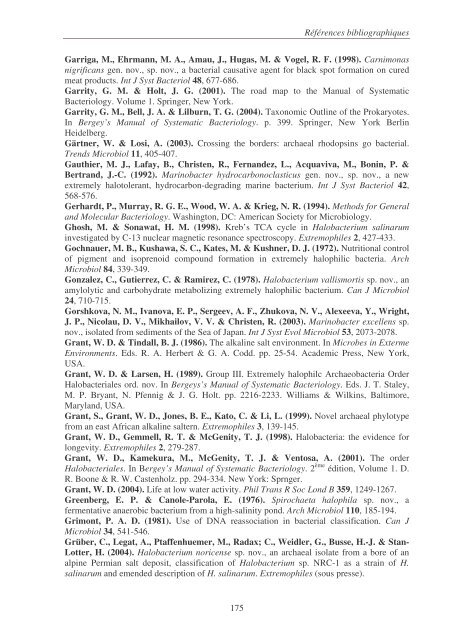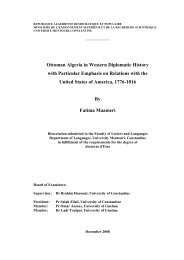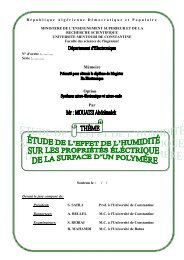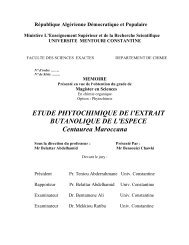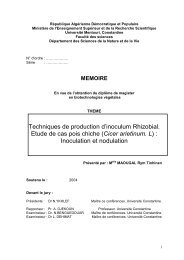(Thèse partie 1)
(Thèse partie 1)
(Thèse partie 1)
Create successful ePaper yourself
Turn your PDF publications into a flip-book with our unique Google optimized e-Paper software.
175<br />
Références bibliographiques<br />
Garriga, M., Ehrmann, M. A., Amau, J., Hugas, M. & Vogel, R. F. (1998). Carnimonas<br />
nigrificans gen. nov., sp. nov., a bacterial causative agent for black spot formation on cured<br />
meat products. Int J Syst Bacteriol 48, 677-686.<br />
Garrity, G. M. & Holt, J. G. (2001). The road map to the Manual of Systematic<br />
Bacteriology. Volume 1. Springer, New York.<br />
Garrity, G. M., Bell, J. A. & Lilburn, T. G. (2004). Taxonomic Outline of the Prokaryotes.<br />
In Bergey’s Manual of Systematic Bacteriology. p. 399. Springer, New York Berlin<br />
Heidelberg.<br />
Gärtner, W. & Losi, A. (2003). Crossing the borders: archaeal rhodopsins go bacterial.<br />
Trends Microbiol 11, 405-407.<br />
Gauthier, M. J., Lafay, B., Christen, R., Fernandez, L., Acquaviva, M., Bonin, P. &<br />
Bertrand, J.-C. (1992). Marinobacter hydrocarbonoclasticus gen. nov., sp. nov., a new<br />
extremely halotolerant, hydrocarbon-degrading marine bacterium. Int J Syst Bacteriol 42,<br />
568-576.<br />
Gerhardt, P., Murray, R. G. E., Wood, W. A. & Krieg, N. R. (1994). Methods for General<br />
and Molecular Bacteriology. Washington, DC: American Society for Microbiology.<br />
Ghosh, M. & Sonawat, H. M. (1998). Kreb’s TCA cycle in Halobacterium salinarum<br />
investigated by C-13 nuclear magnetic resonance spectroscopy. Extremophiles 2, 427-433.<br />
Gochnauer, M. B., Kushawa, S. C., Kates, M. & Kushner, D. J. (1972). Nutritional control<br />
of pigment and isoprenoid compound formation in extremely halophilic bacteria. Arch<br />
Microbiol 84, 339-349.<br />
Gonzalez, C., Gutierrez, C. & Ramirez, C. (1978). Halobacterium vallismortis sp. nov., an<br />
amylolytic and carbohydrate metabolizing extremely halophilic bacterium. Can J Microbiol<br />
24, 710-715.<br />
Gorshkova, N. M., Ivanova, E. P., Sergeev, A. F., Zhukova, N. V., Alexeeva, Y., Wright,<br />
J. P., Nicolau, D. V., Mikhailov, V. V. & Christen, R. (2003). Marinobacter excellens sp.<br />
nov., isolated from sediments of the Sea of Japan. Int J Syst Evol Microbiol 53, 2073-2078.<br />
Grant, W. D. & Tindall, B. J. (1986). The alkaline salt environment. In Microbes in Exterme<br />
Environments. Eds. R. A. Herbert & G. A. Codd. pp. 25-54. Academic Press, New York,<br />
USA.<br />
Grant, W. D. & Larsen, H. (1989). Group III. Extremely halophilc Archaeobacteria Order<br />
Halobacteriales ord. nov. In Bergeys’s Manual of Systematic Bacteriology. Eds. J. T. Staley,<br />
M. P. Bryant, N. Pfennig & J. G. Holt. pp. 2216-2233. Williams & Wilkins, Baltimore,<br />
Maryland, USA.<br />
Grant, S., Grant, W. D., Jones, B. E., Kato, C. & Li, L. (1999). Novel archaeal phylotype<br />
from an east African alkaline saltern. Extremophiles 3, 139-145.<br />
Grant, W. D., Gemmell, R. T. & McGenity, T. J. (1998). Halobacteria: the evidence for<br />
longevity. Extremophiles 2, 279-287.<br />
Grant, W. D., Kamekura, M., McGenity, T. J. & Ventosa, A. (2001). The order<br />
Halobacteriales. In Bergey’s Manual of Systematic Bacteriology. 2 ème édition, Volume 1. D.<br />
R. Boone & R. W. Castenholz. pp. 294-334. New York: Sprnger.<br />
Grant, W. D. (2004). Life at low water activity. Phil Trans R Soc Lond B 359, 1249-1267.<br />
Greenberg, E. P. & Canole-Parola, E. (1976). Spirochaeta halophila sp. nov., a<br />
fermentative anaerobic bacterium from a high-salinity pond. Arch Microbiol 110, 185-194.<br />
Grimont, P. A. D. (1981). Use of DNA reassociation in bacterial classification. Can J<br />
Microbiol 34, 541-546.<br />
Grüber, C., Legat, A., Ptaffenhuemer, M., Radax; C., Weidler, G., Busse, H.-J. & Stan-<br />
Lotter, H. (2004). Halobacterium noricense sp. nov., an archaeal isolate from a bore of an<br />
alpine Permian salt deposit, classification of Halobacterium sp. NRC-1 as a strain of H.<br />
salinarum and emended description of H. salinarum. Extremophiles (sous presse).


